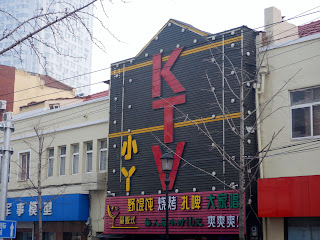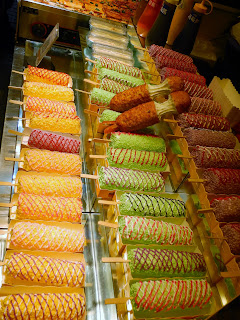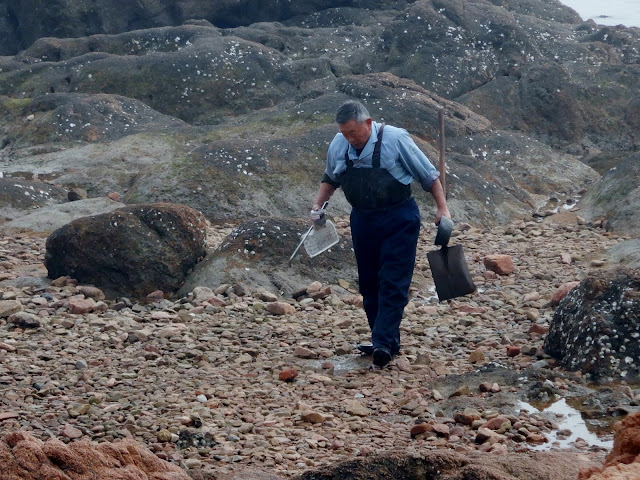Wednesday, February 20, 2019
Qingdao, China
Qingdao (population 8
million) was a once a small fishing village that was conceded to the Germans in
1898 as compensation for the killing of two German missionaries in a local
church. Although Japanese seized the
city in 1914, the German legacy remains.
Qingdao is also a popular resort; tourists
from all over China flock here for the beaches and mild climate. A large Korean
population is here adding to the town’s cosmopolitan flavor. The sail boat
portion of the 2010 Olympics was held here, leaving a modern sailing center to
visit. Sometimes called the Venice of the East, Qingdao is surrounded by water
on three sides and green hills on the other.
What a modern port!
After a quick breakfast,
Larry and I headed out of the long, long port terminal….a chilly one mile walk. It was great to see the people transporters or moving
walkways in operation….we had been warned that they only worked one way. We
found them to work both ways….coming and going.
The bus drive into the city showed us a HUGE smog problem that China is having!
We caught the shuttle bus, a twenty minute ride into the town, seeing a mixture of skyscrapers and old buildings pass by.
The bus drive into the city showed us a HUGE smog problem that China is having!
We caught the shuttle bus, a twenty minute ride into the town, seeing a mixture of skyscrapers and old buildings pass by.
Our drop off point
Upon getting dropped off we walked about a
mile down the busy city street passing an open air food court with all kinds of
unusual tidbits to experience; only we weren’t brave enough to
attempt….
This little alley lead to a display of local cuisine.
octopus
I never thought of eating a star fish, they are too beautiful!
all kinds of seashell succulents, sea cucumbers, prawns, and scallops. We were told to look out for the pig intestines, a favorite among the locals. Yuck! They eat everything here!
octopus
Qingdao is known for the Lu
cuisine which has an emphasis on seafood with a salty, crispy flavor in foods. Bao
(quick fry in very hot oil over high heat) is a common preparation method in Lu
cuisine. We saw much of this in the open air food
stalls.
I never thought of eating a star fish, they are too beautiful!
all kinds of seashell succulents, sea cucumbers, prawns, and scallops. We were told to look out for the pig intestines, a favorite among the locals. Yuck! They eat everything here!
These are the largest shrimp I have ever seen!
Soup or a belly buster?
Steamers...cookware for the dumplings
Either fruit or vegetable kabobs...take a guess!
This street was a ride on the wild side of food available to the Qingdao community!
We saw (through the smog) the Protestant Church
(1910) with German influence sitting on a little hill above the city.
Statues commemorating the German immigrants
Statues commemorating the German immigrants
Onward we hiked down for 20
minutes….a good mile…where we crossed the street through a tunnel of food and
local venders. From there we walked out onto the beach to Qingdao Bay.
Did I mention the smog was so thick that you could not see the oriental building, Huilan Pavilion, out on the 1,500 ft Zhaoqiao Pier, one of the city’s most iconic features? It's just over my left shoulder!
You could actually taste the chemicals in the air. We were told that the smog is at its worst during the winter months due to heating the tall apartment buildings.
Did I mention the smog was so thick that you could not see the oriental building, Huilan Pavilion, out on the 1,500 ft Zhaoqiao Pier, one of the city’s most iconic features? It's just over my left shoulder!
You could actually taste the chemicals in the air. We were told that the smog is at its worst during the winter months due to heating the tall apartment buildings.
From there we walked along
the seaside to our destination, Luxur Park.
We observed the locals out picking at the rocks at low tide for the tiny shells that they were steaming and selling for folks to eat.
Larry and I tried these little critters once in Taiwan a couple of years ago. It was not our choice of a grand snack….being very, very salty.
We observed the locals out picking at the rocks at low tide for the tiny shells that they were steaming and selling for folks to eat.
Larry and I tried these little critters once in Taiwan a couple of years ago. It was not our choice of a grand snack….being very, very salty.
We passed Dutch architecture along our walk.
We walked on for about an hour passing by the numerous boats docked out in the sea and the China Navy Museum. We had a nice little picnic lunch while watching the local fishermen.
The terrain changed drastically as we headed north along the coast.
After hiking through the park, we hailed a taxi and headed back to the bus.
We walked on for about an hour passing by the numerous boats docked out in the sea and the China Navy Museum. We had a nice little picnic lunch while watching the local fishermen.
The terrain changed drastically as we headed north along the coast.
The front entrance into Luxur Park
After hiking through the park, we hailed a taxi and headed back to the bus.
Before getting on the bus we
stopped to warm up. Did I mention it was a cool 35 degrees with a crisp little
wind that would blast us when walking between buildings and crossing the street?
We had the local liquid refreshment….Tsingtao Beer. German settlers built the brewery here in 1903, now the oldest brewery in China as well as the most popular Chinese beer in the US.
We had the local liquid refreshment….Tsingtao Beer. German settlers built the brewery here in 1903, now the oldest brewery in China as well as the most popular Chinese beer in the US.
Larry and I hopped onto the
shuttle bus arriving back at the ship at 3:00pm so glad to go to our warm, toasty room. As we are heading north, our day in Qingdao had been the coldest
day that we had experienced so far on this adventure.































































No comments:
Post a Comment